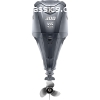I have a 1962 Edinboro and you are right on in your thinking. Seacast is OK - my brother used it to do a self repair on our family's old 1965 Edinboro and it has held up. For mine, I chose to use CarbonCore CarbonBond. It's a little cheaper and now available in 1 gallon sizes, and also I think it's a little easier to do a pour and avoid voids, since it is not as thick as Seacast. However, I had my transom professionally done by a restoration shop, as my transom had a lot of cracked fiberglass damage, as did the motor well, all from the transom wood that had turned into peat moss. Given all the extensive repairs needed, and not wanting to use paint, but rather re-gelcoat the repaired areas, my choice to have a pro do it was an easy decision. More expensive, yes, but for me, worth it. Also, to make sure to have proper bonds, I decided to have the restorer remove the inner skin, leaving a tab, to make removing all the wood easier to complete and also making the fiberglass repairs on both sides of the skin for better strength much, much easier. They used a certain deck rib from a larger old Lyman that matched the radius of the curved MFG transom as a form to get the exact curve back in the repaired transom. Since my boat is one of the very few red deck models still around, and the only one I have ever found for sale with the original Sun 'n Fun seats still with the boat and in pretty good shape, I decided to pay to have the transom, keel and motor well done, while doing the rest myself. (I have found one other 1962 Edinboro with a red deck and red and white seats like mine that is on a You Tube video.) My boat still a work in progress, but getting there.
Mine now weights 865 pounds after those repairs. These boats do have fiberglass stringers, which is one reason why I stick with MFGs of this era. (I also have a 1966 Niagara.) CarbonBond added about 40 pounds to the weight, so I figure my un-repaired weight was about 825 pounds, gotten by weighing the boat on the trailer, then weighting just the trailer, all with the motor off the boat. I think the spec weight is low, as it stayed that weight in the brochures for a long time, then in the late 60's jumped to 934 pounds. The later models had more equipment, including a built-in gas tank. So I figure 825 pounds is OK, as that includes the wiring harness and the control for the motor in that figure. and thus probably weighs no more than about about 35 pounds more than the real original weight. All acceptable to me. I think there is some moisture in the foam under the floor, but 35 pounds is not bad, so I'm not going to go to all the extra trouble and expense to tear out the bonded fiberglass floor.
Water normally gets under the floor if the boat sits out in the weather. The seats are fastened with anodized aluminum brackets that screw into the floor using well nuts. The black rubber deteriorates and lets water in. Interestingly, only every other channel under the floor is foam-filled. Try taking out the floor plug on the outside on the transom (to the right of the bilge plug, as facing the transom), raise the tongue of the trailer up to the stern is low, and see if any water drains out. Water can also get in if there are cracks in the floor (mine has some minor ones) or if there are any holes in the floor - mine had one drilled in the little bilge well at the drain plug area inside the boat. Go figure.
What motor are you now running with, year, make and hp?
I would love to talk to you directly. I'm really into MFG boats, and am a member of the Antique and Classic Boat Society (ACBS - the major all-marque old boat club in the world) and also the Antique Outboard Club (AOMCI). Do you have any pictures? I have tons for mine, here are a few.




























